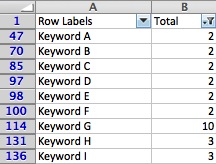As PPC Heroes, we like to think we’ve got all sorts of magic stuffed up our sleeves. Truth be told, there are plenty of approaches we use that may be less common to the outside world. That’s why this week’s *Series Topic* is just that: Underutilized Reports. This week we’ll go over reports we use in AdWords, Bing, Facebook, and Analytics that we find to be particularly useful and perhaps a bit underused in the world of PPC.
This article is going to be about how to determine if you have keyword cross-pollution in your account and why that’s bad. The report being talked about is the Search Query Report with some Pivot Table action being used to determine how big of an issue there is.
Now, I actually think the Search Query Report is one of the most overused reports. It makes lazy negative keywords, lazy keyword research and prevents people from having to think like marketers. Basically, you run a report, see what the word is looking for and then, in your tiny little bubble, decide what is relevant or not. Of course you have some data to back up the decision, but let’s be honest most people look at keywords with only a few keywords or clicks and make decisions.
How do you turn this lazy AdWords report into a money making tool? Think like a marketer.
In this case that means thinking about the right message being in front of the right audience. That applies to SQR’s because they can tell you if you have keywords competing for search queries. This in turn may mean you have some queries being showed less than ideal ads.
Let’s take the search query “Juggalo Fan Club Discount” as an example. Though an SQR we find that it is showing in two different ad groups that contain phrase match keywords. One of the ad groups is for keywords that contain discount, such as “Juggalo Fan club Discount” and one that is more general, such as “Juggalo Fan Club”. (This example also assumes no embedded negatives or exact match [Juggalo Fan Club Discount]).
The discount ad group may have either ad copy-displaying price to dissuade bargain shoppers or a destination URL that offers a special discount to those that are specifically looking for it. And the generic ad group may be more general or go to an “about us” page that the searcher has already seen before. The difference may be only a conversion or two, but across an entire account that could add up to significant dollars.
In the above example you can see that you have the right message for those looking for a discount but because of cross pollution of search terms you are not showing that message for that audience (at least not all the time). But how do you determine if you have this issue of keyword cross-pollution? Pretty simple…
- Run a SQR across an entire account (or if you group campaigns by geo’s or in another way that means you will have search queries show up in the same ad groups intentionally, filter down to only the campaigns you do want to compare).
- Do a pivot table with Search Term in the Labels and Count of Ad Groups in the values. (For each search term this will count the number of ad groups it appears in.)
- This will give you a long list (hundreds of thousands in many cases), so you may want to filter out any with 1 or less. This will leave only those search terms that appear in more than one ad group.
Here’s a snapshot of what this would look like:
You can see Keyword G has appeared in 10 different ad groups! To make this even more useful, you could sum impressions of keywords in another column. This would tell you if this was 10 impression in 10 different ad groups or 100,000 impressions across 10 different ad groups.
Once you have this information you can add exact match negative keywords to the ad groups where you do not want the keyword to show, and/or change your match type strategy to more exact, etc.




